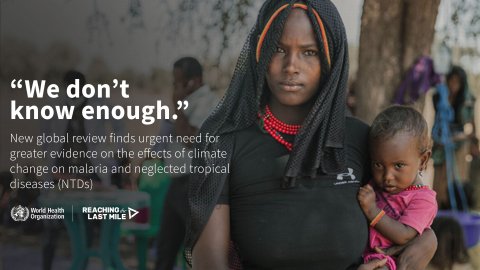WHO article on Climate Change and NTDs published in RSTMH journal

Today, a World Health Organization (WHO) Task Team on Climate Change, NTDs and Malaria, under the guidance of Dr. Socé Fall and with support from the global health philanthropy Reaching the Last Mile, has launched the findings of a major scoping review on the current state of knowledge on the actual and potential impacts of human-induced changes to climate patterns on diseases including malaria, dengue, lymphatic filariasis and leishmaniasis.
Published in our journal Transactions of the Royal Society of Tropical Medicine and Hygiene, the unprecedented review of over 42,693 articles underscores that, while climate change is already leading to significant shifts in the prevalence, incidence, range, or intensity of malaria and a number of NTDs, there are significant gaps in evidence and understanding on the actual and potential impacts of human-induced changes to climate patterns on these diseases. What’s more, the paper highlights what the Task Team has called a growing emergency, in that historical research in this area has focused on countries where there is, in fact, low disease burden and high access to quality healthcare. As a result, anticipated climate-driven shifts in these vector-borne diseases will be felt hardest in those communities disproportionately impacted by them.
Additionally, with just 34% of studies reviewed (174 studies) addressing mitigation strategies and 5% (24 studies) looking at adaptation methods, this review further highlights a lack of evidence required to protect the gains made against malaria and NTDs in recent decades from unravelling at the hands of a climate in crisis.
‘Important and timely review’
Responding to the publication of the review, its lead author, Dr Ibrahima Socé Fall, Director of WHO’s Global NTD Programme, said:
“This important and timely review reveals alarming trends and is a call to urgent action.
“If we are to protect and build upon the hard-won victories of the past two decades, the time to mobilize is right now.
“As a malaria and NTD community, it is imperative that we take a holistic approach to climate change and changing disease patterns. As climate variation allows vector species to proliferate – including in areas that have been relatively untouched by disease– we have to make sure that we have state-of-the-art hazard assessments, and that all our research focuses on the links between hazards, vulnerability, and exposure to disease.
“The findings presented in this major review highlight the need for more comprehensive, collaborative, and standardized modelling, so that we can better understand and predict the effects of climate change on malaria and NTDs, both directly and indirectly.”
‘The scale and direction of the effects of climate on malaria are uncertain’
Dr Daniel Ngamije Madandi, Director of the Global Malaria Programme, said:
“Despite many years of successfully reducing the global malaria burden, progress has stalled and the response is facing some very tough challenges. We know that there will be a profound direct and indirect effect of climate change on malaria.
“The paper provides a valuable clarion call for mitigation and evidence responsive adaptation to climate change. Particularly, as the impact of climate change is likely to be disproportionately borne by the poorest people, who are also disproportionately affected by malaria and NTDs.
“We have recently seen the consequences of extreme weather events on malaria, which are predicted to become more common place. The extreme flooding in Pakistan led to increased malaria transmission and the response was hampered by the massive disruptions.
“Yet, as the paper notes, the scale and direction of the effects of climate on malaria are uncertain and vary by location. We will need more research and modelling to better understand how climate change will directly and indirectly affect malaria, which can ensure we provide the most effective response.
“The report also highlights the critical need for more evidence with regard to a number of the 21 diseases and disease groups that come under the NTD banner. It represents a call for urgent elaboration of strategies to mitigate and adapt to the effects of climate change, as rising temperatures across the world, and changes to precipitation patterns, have the potential to produce more fertile conditions for vectors to reproduce and for pathogens to develop.”
'Action needs to be taken'
Tamar Ghosh, RSTMH Chief Executive, said: “We are delighted to be publishing this article in our journal Transactions of the Royal Society of Tropical Medicine and Hygiene.
“This article shows that action needs to be taken to limit the impact of Climate Change on NTDs. We hope this will be prioritised and stimulate even more research in this area to drive the changes needed in preparedness, practice and policy.”
The data presented in the review suggest that the effects of climate change on malaria and NTDs will vary significantly by disease and by location, that these effects will exhibit non-linear patterns, and that they will evolve over time.
In order to assess the impact of climate change on malaria and NTDs, this state-of-the-art scoping review analysed peer-reviewed papers and grey literature published between January 2010 and October 2023, with investigators summarizing the identified data and analysing the distribution of studies by country.
In total, 42,693 records were retrieved, from which 1,543 full-text papers were examined. Researchers correlated the number of publications with national disease burdens, the Healthcare Access and Quality Index (HAQI), and climate vulnerability scores. Of the 511 papers that met the inclusion criteria, 185 papers addressed malaria, 181 focused on dengue and chikungunya, and 53 reported outcomes on leishmaniasis. Other NTDs, however, were significantly under-represented, having not been sufficiently studied.